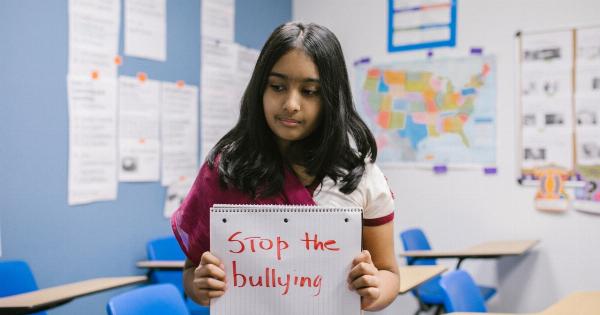Childhood and teenage depression is a serious mental health condition that can have long-lasting effects on a young person’s well-being.
It is important to understand the risk factors associated with this condition in order to identify and provide timely support and treatment. Here are some key risk factors that contribute to the development of depression in children and adolescents:.
1. Family History of Depression
Having a close family member, such as a parent or sibling, who has experienced depression increases the likelihood of a child or teenager developing the condition.
This suggests a genetic predisposition to depression and highlights the importance of considering family history when assessing risk.
2. Traumatic Life Events
Exposure to traumatic experiences, such as abuse, neglect, or the loss of a loved one, can significantly increase the risk of depression in children and teenagers.
Trauma disrupts their sense of security and stability, leaving them more vulnerable to developing mental health issues.
3. Chronic Illness or Physical Health Problems
Children and teenagers who suffer from chronic medical conditions or ongoing physical health problems are at a higher risk of experiencing depression.
The stress, pain, and limitations associated with these conditions can significantly impact their emotional well-being.
4. Academic or Social Pressure
The pressures of academic performance and social expectations can take a toll on young individuals.
The constant need to excel academically, fit in socially, or achieve certain standards can contribute to feelings of inadequacy, low self-esteem, and ultimately lead to depression.
5. Substance Abuse
Substance abuse, including alcohol and drug use, is a significant risk factor for depression in teenagers.
Substance abuse can disrupt brain chemistry and contribute to feelings of hopelessness and emptiness, increasing the vulnerability to depressive symptoms.
6. Gender
The risk of depression varies between genders during adolescence. While boys may experience depression, girls are more likely to develop the condition.
This difference may be influenced by hormonal changes, societal expectations, or differences in coping mechanisms.
7. Bullying or Social Rejection
Experiencing bullying or social rejection can have severe psychological consequences for children and teenagers. The constant harassment, humiliation, and isolation can lead to feelings of sadness, loneliness, and eventually depression.
8. Lack of Supportive Relationships
Children and teenagers who lack supportive relationships, both within their family and their social circles, are at a higher risk of developing depression.
The absence of positive connections can leave them feeling isolated, misunderstood, and without the necessary emotional support.
9. High Levels of Stress
Intense and chronic stress can overwhelm children and teenagers, increasing their vulnerability to depression. Stressful environments, whether at home, school, or in their communities, can significantly impact their mental well-being.
10. Early Childhood Adversity
Early childhood adversity, such as neglect, abuse, or exposure to violence, can have profound and long-lasting effects on a child’s mental health.
These experiences can shape their brain development, making them more susceptible to mental health disorders, including depression.
Symptoms of Childhood and Teenage Depression
Recognizing the symptoms of depression in children and teenagers is crucial for early intervention and support. While individuals may experience depression differently, some common symptoms include:.
1. Persistent Sadness or Irritability
Children and teenagers with depression may exhibit a persistent and unexplained sadness or irritability. They may seem constantly unhappy, moody, or easily angered.
2. Social Withdrawal and Isolation
Depressed individuals may withdraw from social activities and isolate themselves from family and friends. They may lose interest in activities they once enjoyed and prefer to be alone.
3. Changes in Sleep Patterns
Depression can disrupt normal sleep patterns. Children and teenagers may experience difficulty falling asleep, staying asleep, or sleeping excessively.
4. Loss of Energy and Fatigue
Depression can drain a person’s energy, leading to feelings of constant fatigue and low motivation. Children and teenagers may appear sluggish or lack the usual enthusiasm for life.
5. Lack of Concentration and School Performance Decline
Depression can impair cognitive functions, making it difficult for children and teenagers to concentrate and perform well academically. Their grades may decline, and they may struggle to stay focused.
6. Changes in Appetite or Weight
Depression can affect a person’s appetite, leading to significant weight loss or weight gain. Children and teenagers may experience changes in their eating habits and body weight.
7. Feelings of Guilt or Worthlessness
Depressed individuals often experience intense feelings of guilt, worthlessness, or self-blame. They may believe they are a burden to others or have a distorted perception of their abilities.
8. Recurrent Physical Complaints
Some children and teenagers may manifest their depression through physical symptoms such as headaches, stomachaches, or other unexplained pains. These complaints may not respond to medical treatment.
9. Suicidal Thoughts or Self-Harm
In severe cases of depression, children and teenagers may exhibit thoughts of self-harm or suicide. Any mention or indication of self-harm should be taken seriously, and immediate professional help should be sought.
10. Disruptive Behavior
Depression can sometimes manifest as disruptive or rebellious behavior. Instead of appearing sad, children and teenagers with depression may act out, engage in risky behaviors, or show signs of aggression.
Treatment Options for Childhood and Teenage Depression
Early intervention and appropriate treatment are essential in effectively managing childhood and teenage depression. There are several treatment options available, depending on the severity of the condition and the unique needs of the individual.
Here are some commonly used treatments:.
1. Psychotherapy (Talk Therapy)
Psychotherapy involves talking to a trained therapist who helps the child or teenager explore their thoughts, feelings, and behaviors.
Cognitive-behavioral therapy (CBT) and interpersonal therapy (IPT) are often used to address depression in young individuals.
2. Medication
In severe cases of depression, medication may be prescribed to help manage symptoms. Antidepressant medication, such as selective serotonin reuptake inhibitors (SSRIs), can be beneficial when used in combination with therapy.
3. Family Support and Education
Involving the family in the treatment process is crucial. Providing education about depression, teaching coping skills, and fostering a supportive home environment can all contribute to the recovery and well-being of the child or teenager.
4. Lifestyle Changes
Encouraging healthy lifestyle habits can have a positive impact on a young person’s mental health. Regular exercise, balanced nutrition, sufficient sleep, and stress management techniques can all aid in reducing depressive symptoms.
5. Peer Support and Group Therapy
Engaging in peer support programs and group therapy can provide children and teenagers with a sense of belonging and validation. Sharing experiences and coping strategies with others who have similar struggles can be highly beneficial.
6. School-Based Interventions
Schools can play a vital role in supporting students with depression.
Implementing programs that raise awareness, promote mental health education, provide counseling services, and create a safe and inclusive environment can greatly benefit affected individuals.
7. Mindfulness and Relaxation Techniques
Teaching mindfulness and relaxation techniques, such as deep breathing exercises and meditation, can help children and teenagers manage stress and develop better emotional regulation skills.
8. Continuum of Care
Depression is a chronic condition that requires ongoing care and support. Ensuring continuity of care, including regular monitoring, follow-up appointments, and adjustments to treatment plans, is crucial for long-term management.
9. Holistic Approaches
Some individuals may benefit from holistic approaches, such as art therapy, music therapy, or animal-assisted therapy. These alternative therapies can provide additional avenues for emotional expression and healing.
10. Collaborative Approach
The treatment of childhood and teenage depression works best when there is a collaborative approach involving the child or teenager, family, mental health professionals, and relevant support services.
Open communication and a united effort lead to better outcomes.






























